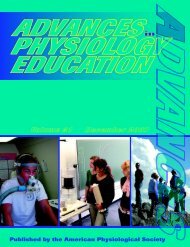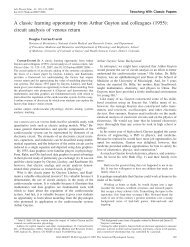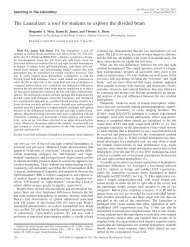construction of a model demonstrating neural pathways and reflex arcs
construction of a model demonstrating neural pathways and reflex arcs
construction of a model demonstrating neural pathways and reflex arcs
You also want an ePaper? Increase the reach of your titles
YUMPU automatically turns print PDFs into web optimized ePapers that Google loves.
INNOVATIONS A N D I D E A S<br />
J. When the action potential is relayed to the cerebral<br />
cortex, the buzzer will sound. This signifies that the<br />
cerebral cortex has received information concerning<br />
the painful stimulus. You are now aware <strong>of</strong> pain in<br />
your body, <strong>and</strong> you also know exactly where that pain<br />
is located. Again, discuss with your partner what is<br />
happening along this pathway.<br />
QUESTIONS. 2) Describe the difference between the<br />
monosynaptic <strong>reflex</strong>/patellar tendon <strong>reflex</strong> <strong>and</strong> the<br />
withdrawal <strong>reflex</strong> upon painful stimulus.<br />
2) Explain why both lamps light up in the with-<br />
drawal <strong>reflex</strong> upon painful stimulus when the system<br />
is initially turned on.<br />
3) In the pain <strong>reflex</strong>, discuss the advantages <strong>of</strong> a<br />
pathway that reaches higher brain centers over a<br />
monosynaptic pathway.<br />
4) How is the cerebral cortex involved in a pain/<br />
temperature <strong>reflex</strong>? Explain your answer thoroughly.<br />
5)WHATWOULDHAPPENIF:... the receptor were nonfunc-<br />
tional? . . . the afferent (sensory) neuron were cut? . . .the<br />
efferent (motor) neuron were cut? . ..the neuron<br />
between the thalamus <strong>and</strong> cerebral cortex were cut?<br />
When answering this question, use the approach that<br />
cutting a neuron would be equivalent to driving down<br />
a road that suddenly dead-ended.<br />
ANSWERS (WITHDRAWAL REFLEX UPON PAINFIJL STIMULUS). 1)<br />
There are two major differences between the two<br />
<strong>reflex</strong>es. Obviously, the polysynaptic withdrawal re-<br />
flex upon painful stimulus is more complex. It con-<br />
tains an interneuron between the sensory neuron <strong>and</strong><br />
motor neuron. In contrast, the corresponding part <strong>of</strong><br />
the patellar tendon <strong>reflex</strong> is monosynaptic with a<br />
direct link between the alfimxt <strong>and</strong> e@erent neurons.<br />
The second difference involves the conscious aware-<br />
ness <strong>of</strong> pain. This leads to further processing for<br />
learning <strong>and</strong> memory. This second component <strong>of</strong> the<br />
pathway involves the thalamus <strong>and</strong> the cerebral cor-<br />
tex. Note that the monosynaptic <strong>reflex</strong> does not<br />
involve the brain at all.<br />
2) Two synaptic junctions are simultaneously stimu-<br />
lated by the axon <strong>of</strong> the initial sensory neuron. This<br />
allows two action potentials to be initiated at the same<br />
time. One will cause an immediate withdrawal <strong>of</strong> the<br />
limb at which the stimulus is received, <strong>and</strong> the other<br />
informs the brain that pain has occurred somewhere<br />
in the body. It also causes subsequent actions as<br />
needed.<br />
3) Because the cortex has the ability to store memo-<br />
ries <strong>and</strong> interpret information over time, this will lead<br />
to the avoidance <strong>of</strong> situations that cause pain. If the<br />
pain withdrawal <strong>reflex</strong> did not involve the cerebral<br />
cortex, there would be no previous knowledge about<br />
pain or learning involved. We would therefore not<br />
know to avoid painful sensations, <strong>and</strong> we would be<br />
destined to repeat them.<br />
4) The involvement <strong>of</strong> the cerebral cortex provides an<br />
awareness <strong>of</strong> pain <strong>and</strong> simultaneously pinpoints the<br />
location <strong>of</strong> pain in the body. This can lead to a<br />
secondary reaction such as grabbing the injured body<br />
part or placing a burned finger in your mouth or<br />
holding it under cold water. The cerebral cortex can<br />
also interpret more information over time that leads to<br />
the creation <strong>of</strong> a memory. This leads to the avoidance<br />
<strong>of</strong> a situation that involves a painful stimulus.<br />
5) WHAT WOIJI,D HAPPEN TF.. the receptor were nonfunc-<br />
tional? If the receptor were nonfunctional, there<br />
would be no sensory input received. Therefore, there<br />
would be no withdrawal from the harmful stimulus.<br />
Bodily harm could occur. For example, someone<br />
without a functional receptor might severely burn or<br />
cut their h<strong>and</strong> without realizing it.<br />
Note that the muscle would still be functional, <strong>and</strong><br />
other <strong>neural</strong> impulses that caused the muscle to move,<br />
such as during exercise, would function normally.<br />
. . .the afferent (sensory) neuron were cut? If the<br />
afferent (sensory) neuron were cut, the receptor<br />
would be able to receive the stimulus. The receptor<br />
could also pass on the information it received to the<br />
sensory neuron, but the sensory neuron would not be<br />
able to transmit its information. So, no sensory informa-<br />
tion would be passed on to the interneuron or to the<br />
VOLUME 16 : NUMBER 1 - ADVANCES IN PHYSIOLOGY EDUCATION - DECEMBER 1996<br />
s41









